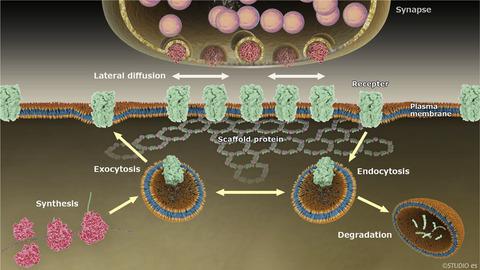当前位置:
X-MOL 学术
›
Dev. Growth Differ.
›
论文详情
Our official English website, www.x-mol.net, welcomes your
feedback! (Note: you will need to create a separate account there.)
Inhibitory synaptic transmission tuned by Ca2+ and glutamate through the control of GABAA R lateral diffusion dynamics.
Development, Growth & Differentiation ( IF 1.7 ) Pub Date : 2020-04-23 , DOI: 10.1111/dgd.12667
Hiroko Bannai 1, 2, 3, 4 , Fumihiro Niwa 4, 5 , Shigeo Sakuragi 1, 6 , Katsuhiko Mikoshiba 4, 7, 8
Development, Growth & Differentiation ( IF 1.7 ) Pub Date : 2020-04-23 , DOI: 10.1111/dgd.12667
Hiroko Bannai 1, 2, 3, 4 , Fumihiro Niwa 4, 5 , Shigeo Sakuragi 1, 6 , Katsuhiko Mikoshiba 4, 7, 8
Affiliation

|
The GABAergic synapses, a primary inhibitory synapse in the mammalian brain, is important for the normal development of brain circuits, and for the regulation of the excitation‐inhibition balance critical for brain function from the developmental stage throughout life. However, the molecular mechanism underlying the formation, maintenance, and modulation of GABAergic synapses is less understood compared to that of excitatory synapses. Quantum dot‐single particle tracking (QD‐SPT), a super‐resolution imaging technique that enables the analysis of membrane molecule dynamics at single‐molecule resolution, is a powerful tool to analyze the behavior of proteins and lipids on the plasma membrane. In this review, we summarize the recent application of QD‐SPT in understanding of GABAergic synaptic transmission. Here we introduce QD‐SPT experiments that provide further insights into the molecular mechanism supporting GABAergic synapses. QD‐SPT studies revealed that glutamate and Ca2+ signaling is involved in (a) the maintenance of GABAergic synapses, (b) GABAergic long‐term depression, and GABAergic long‐term potentiation, by specifically activating signaling pathways unique to each phenomenon. We also introduce a novel Ca2+ imaging technique to describe the diversity of Ca2+ signals that may activate the downstream signaling pathways that induce specific biological output.
中文翻译:

Ca2 +和谷氨酸通过控制GABAA R横向扩散动力学来调节突触传递。
GABA能突触是哺乳动物大脑中的主要抑制性突触,对于大脑回路的正常发育以及从一生的发育阶段调节对于大脑功能至关重要的兴奋抑制平衡至关重要。但是,与兴奋性突触相比,对GABA能突触的形成,维持和调节的分子机制了解较少。量子点单粒子跟踪(QD-SPT)是一种超分辨率成像技术,能够以单分子分辨率分析膜分子动力学,是分析质膜上蛋白质和脂质行为的强大工具。在这篇综述中,我们总结了QD-SPT在了解GABA能突触传递中的最新应用。在这里,我们介绍QD-SPT实验,以进一步了解支持GABA能突触的分子机制。QD-SPT研究表明,谷氨酸和钙2+信号传导通过特异性激活每种现象所特有的信号传导途径参与(a)GABA能突触的维持,(b)GABA能长期抑制和GABA能长期增强。我们还介绍了一种新颖的Ca 2+成像技术来描述Ca 2+信号的多样性,该信号可能激活诱导特定生物学输出的下游信号通路。
更新日期:2020-04-23
中文翻译:

Ca2 +和谷氨酸通过控制GABAA R横向扩散动力学来调节突触传递。
GABA能突触是哺乳动物大脑中的主要抑制性突触,对于大脑回路的正常发育以及从一生的发育阶段调节对于大脑功能至关重要的兴奋抑制平衡至关重要。但是,与兴奋性突触相比,对GABA能突触的形成,维持和调节的分子机制了解较少。量子点单粒子跟踪(QD-SPT)是一种超分辨率成像技术,能够以单分子分辨率分析膜分子动力学,是分析质膜上蛋白质和脂质行为的强大工具。在这篇综述中,我们总结了QD-SPT在了解GABA能突触传递中的最新应用。在这里,我们介绍QD-SPT实验,以进一步了解支持GABA能突触的分子机制。QD-SPT研究表明,谷氨酸和钙2+信号传导通过特异性激活每种现象所特有的信号传导途径参与(a)GABA能突触的维持,(b)GABA能长期抑制和GABA能长期增强。我们还介绍了一种新颖的Ca 2+成像技术来描述Ca 2+信号的多样性,该信号可能激活诱导特定生物学输出的下游信号通路。

































 京公网安备 11010802027423号
京公网安备 11010802027423号